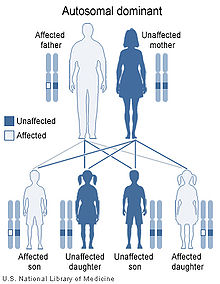- Currarino syndrome
-
Currarino syndrome Classification and external resources 
An X-ray showing Imperforate anusOMIM 176450 DiseasesDB 33509 The Currarino syndrome (also Currarino triad) is an inherited congenital disorder where (1) the sacrum (the fused vertebrae forming the back of the pelvis) is not formed properly, (2) there is a mass in the presacral space in front of the sacrum, and (3) there are malformations of the anus or rectum. It can also cause an anterior meningocele or a presacral teratoma.
Presacral teratoma usually is considered to be a variant of sacrococcygeal teratoma. However, the presacral teratoma that is characteristic of the Currarino syndrome may be a distinct kind.[1]
Genetics
The disorder is an autosomal dominant genetic trait[2] caused by a mutation in the HLXB9 homeobox gene.
 Currarino syndrome has an autosomal dominant pattern of inheritance
Currarino syndrome has an autosomal dominant pattern of inheritance
References
- ^ Gopal M, Turnpenny PD, Spicer R (June 2007). "Hereditary sacrococcygeal teratoma--not the same as its sporadic counterpart!". Eur J Pediatr Surg 17 (3): 214–6. doi:10.1055/s-2007-965121. PMID 17638164.
- ^ Ashcraft KW, Holder TM (October 1974). "Hereditary presacral teratoma". J. Pediatr. Surg. 9 (5): 691–7. doi:10.1016/0022-3468(74)90107-9. PMID 4418917. http://linkinghub.elsevier.com/retrieve/pii/0022-3468(74)90107-9.
Congenital malformations and deformations of nervous system (Q00–Q07, 740–742) Brain Anencephaly (Acephaly, Acrania, Acalvaria, Iniencephaly) · Encephalocele · Arnold–Chiari malformationOtherCNS cyst (Porencephaly, Schizencephaly)Spinal cord OtherGenetic disorder, protein biosynthesis: Transcription factor/coregulator deficiencies (1) Basic domains 1.2: Feingold syndrome · Saethre-Chotzen syndrome
1.3: Tietz syndrome(2) Zinc finger
DNA-binding domains2.1 (Intracellular receptor): Thyroid hormone resistance · Androgen insensitivity syndrome (PAIS, MAIS, CAIS) · Kennedy's disease · PHA1AD pseudohypoaldosteronism · Estrogen insensitivity syndrome · X-linked adrenal hypoplasia congenita · MODY 1 · Familial partial lipodystrophy 3 · SF1 XY gonadal dysgenesis
2.2: Barakat syndrome · Tricho–rhino–phalangeal syndrome
2.3: Greig cephalopolysyndactyly syndrome/Pallister-Hall syndrome · Denys–Drash syndrome · Duane-radial ray syndrome · MODY 7 · MRX 89 · Townes–Brocks syndrome · Acrocallosal syndrome · Myotonic dystrophy 2
2.5: Autoimmune polyendocrine syndrome type 1(3) Helix-turn-helix domains 3.1: ARX (Ohtahara syndrome, Lissencephaly X2) · HLXB9 (Currarino syndrome) · HOXD13 (SPD1 Synpolydactyly) · IPF1 (MODY 4) · LMX1B (Nail–patella syndrome) · MSX1 (Tooth and nail syndrome, OFC5) · PITX2 (Axenfeld syndrome 1) · POU4F3 (DFNA15) · POU3F4 (DFNX2) · ZEB1 (Posterior polymorphous corneal dystrophy 3, Fuchs' dystrophy 3) · ZEB2 (Mowat-Wilson syndrome)
3.2: PAX2 (Papillorenal syndrome) · PAX3 (Waardenburg syndrome 1&3) · PAX4 (MODY 9) · PAX6 (Gillespie syndrome, Coloboma of optic nerve) · PAX8 (Congenital hypothyroidism 2) · PAX9 (STHAG3)
3.3: FOXC1 (Axenfeld syndrome 3, Iridogoniodysgenesis, dominant type) · FOXC2 (Lymphedema–distichiasis syndrome) · FOXE1 (Bamforth–Lazarus syndrome) · FOXE3 (Anterior segment mesenchymal dysgenesis) · FOXF1 (ACD/MPV) · FOXI1 (Enlarged vestibular aqueduct) · FOXL2 (Premature ovarian failure 3) · FOXP3 (IPEX)
3.5: IRF6 (Van der Woude syndrome, Popliteal pterygium syndrome)(4) β-Scaffold factors
with minor groove contacts4.2: Hyperimmunoglobulin E syndrome
4.3: Holt-Oram syndrome · Li-Fraumeni syndrome · Ulnar–mammary syndrome
4.7: Campomelic dysplasia · MODY 3 · MODY 5 · SF1 (SRY XY gonadal dysgenesis, Premature ovarian failure 7) · SOX10 (Waardenburg syndrome 4c, Yemenite deaf-blind hypopigmentation syndrome)
4.11: Cleidocranial dysostosis(0) Other transcription factors 0.6: Kabuki syndromeUngrouped Transcription coregulators Categories:- Disease stubs
- Rare diseases
- Syndromes
- Congenital disorders of nervous system
- Autosomal dominant disorders
Wikimedia Foundation. 2010.
